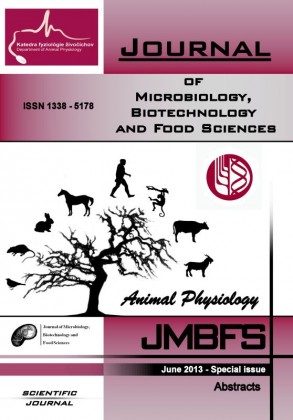USE OF ISCADOR, AN EXTRACT OF MISTLETOE (VISCUM ALBUM L.), IN TREATMENT
Keywords:
Iscador, cancer, oxidative stress, miceAbstract
The functional role of oxidative stress in cancer pathogenesis has long been a hotly debated topic. A study by Goh et al., directly addresses this issue by using a molecular genetic approach, via an established mouse animal model of human breast cancer. More specifically, alleviation of mitochondrial oxidative stress, via transgenic over-expression of catalase (an anti-oxidant enzyme) targeted to mitochondria, was sufficient to lower tumor grade (from high-to-low) and to dramatically reduce metastatic tumor burden by >12-fold (Goh et al., 2011). The oxidative stress directly contributes to tumor progression and metastasis. The damaging effects induced by ROS and by other free radicals include a number of oxidative modifications and/or alterations of critical molecules in a complex reactive scheme, which is defined as oxidative stress (OS). Molecular targets of ROS include unsaturated phospholipids, proteins, carbohydrates and nucleic acids (DNA or RNA). Consequently, the structure and viability of cell functions become compromised. Therefore, it is generally accepted that OS is involved in the physiopathology of degenerative diseases, including the ageing process and cancer. These result have important clinical and translational significance, as most current chemo-therapeutic agents and radiation therapy increase oxidative stress, and, therefore, could help drive tumor recurrence and metastasis. Similarly, chemo- and radiation-therapy both increase the risk for developing a secondary malignancy, such as leukemia and/or lymphoma. To effectively reduce mitochondrial oxidative stress, should be now re-consider the use of natural products as a component of patient therapy and cancer prevention In support of this idea, vegetarians, who consume a diet rich in anti-oxidants, have reduced rates of cancer incidence, have longer life expectancies, and suffer less from dementia (Fraser, 2009). Currently, health beneficial roles of natural products attract much attention and diverse functional ingredients have been extensively studied their preventive effect in many diseases such as cardiovascular diseases and cancer. Iscador preparations are used as complementary therapy in the conventional anticancer treatment (Klopp et al., 2005). These are aqueous extracts of mistletoe (Viscum album L.) parasitizing apple tree (Iscador M), oak (Iscador Qu) or pine tree (Iscador P). They contain a variety of bioactive substances. The greatest therapeutic effect, particularly in the anticancer therapy, has been associated with viscumins and viscotoxins. As shown on various cells lines in culture, Iscador preparations are cytotoxic to cancer cells but have little effect on normal cells (Hubert et al., 2006).The aim of the present study was to investigate the antioxidant capacity and the possible protective effects of Iscador on the antioxidant system in mice.
The experiments were carried out on male mice, average body weight 25 – 26g, bred in the constant light conditions LD 12:12 and fed with standard diet with unlimited access to water. The animals were divided into four groups: one control and three experimental groups. The control mice were administered physiological salts. The first experimental group was administered iscador Qu at 5 mgkgˉ1 b.w. for 4 days, the second group: iscador M at 5 mgkgˉ1 b.w. for 4 days, while the third group was administered iscador P at 5 mgkgˉ1 b.w. for 4 days. All injections were administered intramuscularly at the volume of 100 µL.
Thirty minutes after the fourth injection animals were anaesthetized and decapitated. The blood samples were collected from the carotid artery. CAT, SOD and GPx activity, and GSH concentration in the blood serum were determined. Levels of glutathione (GSH), glutathione peroxidase (GPx), catalase (CAT) and superoxide dismutase (SOD) activity were measured as surrogate markers of oxidative stress. The analysis of the markers of oxidative stress in blood serum has shown an increase their activity after injections of Iscador Qu, M and P as compared to the control group, with the highest increase after the administration of Iscador Qu. The analyzed studies give some evidence that Iscador treatment might have beneficial effect on antioxidant system in organism.
Downloads
Download data is not yet available.
Downloads
Published
2013-06-06
How to Cite
GreÅ„, A., Formicki, G., Massanyi, P., Szaroma, W., LukáÄ, N., & Kapusta, E. (2013). USE OF ISCADOR, AN EXTRACT OF MISTLETOE (VISCUM ALBUM L.), IN TREATMENT. Journal of Microbiology, Biotechnology and Food Sciences, 2(Abstracts special issue), 19–20. Retrieved from https://office2.jmbfs.org/index.php/JMBFS/article/view/7549
Issue
Section
Biotechnology
License
Copyright (c) 2013 Agnieszka GreÅ„, Grzegorz Formicki, Peter Massanyi, Waldemar Szaroma, Norbert LukáÄ, Edyta Kapusta

This work is licensed under a Creative Commons Attribution 4.0 International License.
All papers published in the Journal of Microbiology, Biotechnology and Food Sciences are published under a CC-BY licence (CC-BY 4.0). Published materials can be shared (copy and redistribute the material in any medium or format) and adapted (remix, transform, and build upon the material for any purpose, even commercially) with specifying the author(s).

